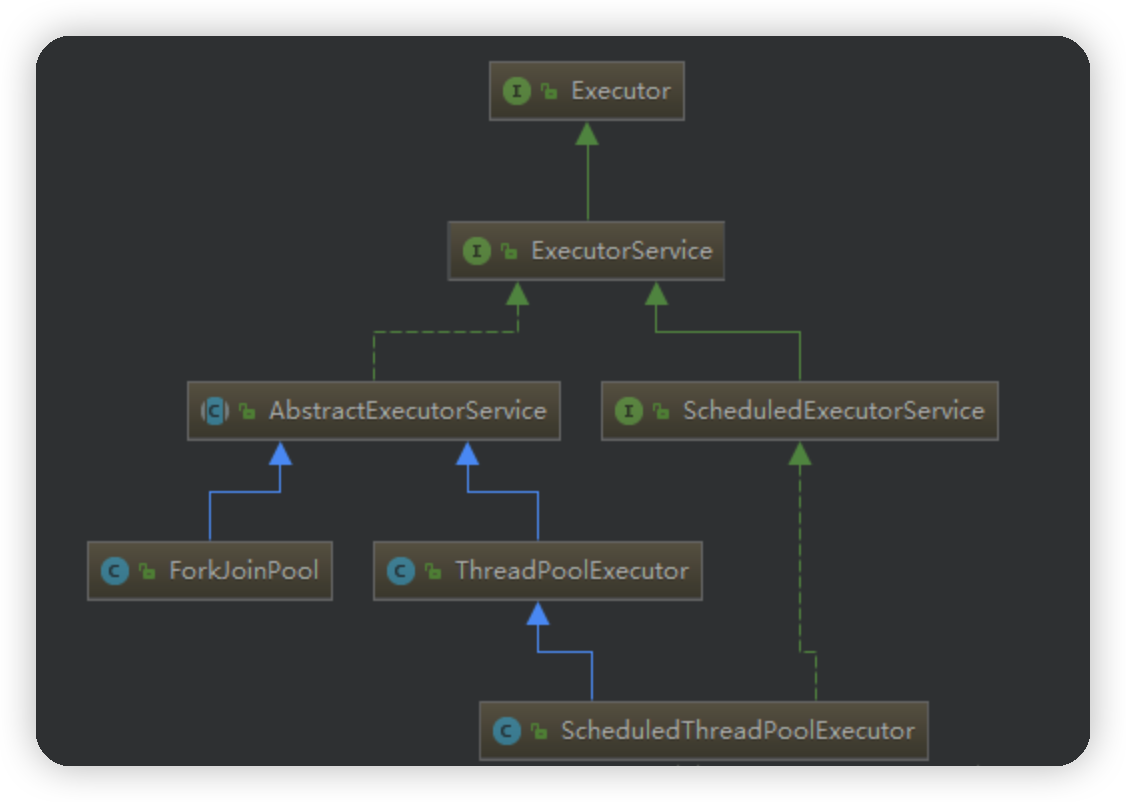ThreadPoolTaskExecutor是spring core包中的。
ThreadPoolExecutor是JDK中的JUC。
ThreadPoolTaskExecutor是对ThreadPoolExecutor进行了封装处理。

1.自定义线程池
import java.util.concurrent.ThreadFactory;import java.util.concurrent.atomic.AtomicInteger;public class NamedThreadFactory implements ThreadFactory {private static final AtomicInteger poolNumber = new AtomicInteger(1);private final AtomicInteger threadNumber = new AtomicInteger(1);private String namePrefix;private final ThreadGroup group;public NamedThreadFactory( String name ) {this.namePrefix = namePrefix = name + "-" + poolNumber.getAndIncrement() + "-thread-";SecurityManager s = System.getSecurityManager();group = (s != null) ? s.getThreadGroup() : Thread.currentThread().getThreadGroup();}@Overridepublic Thread newThread(Runnable r) {Thread t = new Thread(group, r, namePrefix + threadNumber.getAndIncrement(), 0);if (t.isDaemon())t.setDaemon(false);if (t.getPriority() != Thread.NORM_PRIORITY)t.setPriority(Thread.NORM_PRIORITY);return t;}}
import org.springframework.context.annotation.Bean;import org.springframework.context.annotation.Configuration;import org.springframework.scheduling.annotation.EnableAsync;import org.springframework.scheduling.concurrent.ThreadPoolTaskExecutor;import java.util.concurrent.ThreadPoolExecutor;@Configurationpublic class ThreadPoolConfig {@Beanpublic ThreadPoolTaskExecutor myThreadPoolTaskExecutor() {ThreadPoolTaskExecutor myThreadPoolTaskExecutor = new ThreadPoolTaskExecutor();//线程池维护线程的最少数量/*** N为cpu个数* 如果是CPU密集型应用,则线程池大小设置为N+1* 如果是IO密集型应用,则线程池大小设置为2N+1* 此方法返回可用处理器的虚拟机的最大数量; 不小于1* Runtime.getRuntime().availableProcessors();* linux查询方式:* cat /proc/cpuinfo| grep "processor"| wc -l*///配置核心线程数myThreadPoolTaskExecutor.setCorePoolSize(5);//配置最大线程数myThreadPoolTaskExecutor.setMaxPoolSize(6);//配置队列大小myThreadPoolTaskExecutor.setQueueCapacity(200);//设置保活秒数myThreadPoolTaskExecutor.setKeepAliveSeconds(60);//配置线程池中的线程的名称前缀myThreadPoolTaskExecutor.setThreadNamePrefix("Async-Thread-");//rejection-policy:设置拒绝策略,当pool已经达到max size的时候,如何处理新任务//CALLER_RUNS:不在新线程中执行任务,而是有调用者所在的线程来执行myThreadPoolTaskExecutor.setRejectedExecutionHandler(new ThreadPoolExecutor.CallerRunsPolicy());//设置等待任务完成时关机myThreadPoolTaskExecutor.setWaitForTasksToCompleteOnShutdown(true);//设置等待终止时间myThreadPoolTaskExecutor.setAwaitTerminationSeconds(60);//执行初始化myThreadPoolTaskExecutor.initialize();// 设置线程池中的线程的名称前缀(创建线程或线程池时请指定有意义的线程名称,方便出错时回溯)myThreadPoolTaskExecutor.setThreadFactory(new NamedThreadFactory("Async-ThreadPool-"));return myThreadPoolTaskExecutor;}}
2.某个实现类中的某个方法使用线程池
import com.xqny.logtest.service.ExecutorService;import lombok.SneakyThrows;import org.springframework.scheduling.annotation.Async;import org.springframework.scheduling.concurrent.ThreadPoolTaskExecutor;import org.springframework.stereotype.Service;import javax.annotation.Resource;import java.util.concurrent.CompletableFuture;/*** @author Raint* @date 2022年04月13日 11:37*/@Service("ExecutorService")public class ExecutorServiceImpl implements ExecutorService {@Resourceprivate ThreadPoolTaskExecutor myThreadPoolTaskExecutor; // myThreadPoolTaskExecutor 为beanName@Override@SneakyThrowspublic void testasync(){CompletableFuture<Void> completableFuture1 = CompletableFuture.runAsync(() -> {try {Thread.sleep(2000);} catch (InterruptedException e) {e.printStackTrace();}System.out.println("业务线程1");}, myThreadPoolTaskExecutor);CompletableFuture<Void> completableFuture2 = CompletableFuture.runAsync(() -> {try {Thread.sleep(5000);} catch (InterruptedException e) {e.printStackTrace();}System.out.println("业务线程2");}, myThreadPoolTaskExecutor);// 等待两个线程执行完CompletableFuture.allOf(completableFuture1, completableFuture2).get();return;}}
第一个线程睡眠2秒,第二个现场睡眠5秒,异步执行时间为5秒,而不是7秒

